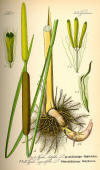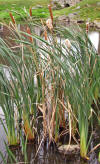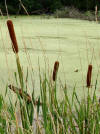WILD
FOODIES' HOME PAGE
PLANT PROFILE LIST
NAME: Cattail (2 species)
SPECIES
/ FAMILY: Typha Angustifolia / Typhaceae
Typha Latifolia / Typhaceae
OTHER COMMON NAME(S): Small Reed Mace, Narrowleaf cattail
Reedmace,
Broadleaf cattail, Bullrush
CONDITIONS: sun, ponds, marsh
|
PARTS: |
EDIBLE |
TASTE |
RAW/COOK |
SEASON |
|
All |
|
|
|
|
|
Shoots |
|
|
RAW/COOK |
Spring |
|
Leaves |
|
|||
|
Stalk/Stem |
|
sweet corn |
RAW/COOK |
|
|
Buds |
||||
|
Flowers |
|
|
RAW/COOK |
|
|
Fruits |
|
|
|
|
|
Pods |
|
|||
|
Seeds |
|
nutty |
ROAST |
|
|
Nuts |
|
|
|
|
|
Roots |
|
sweet |
RAW/COOK |
|
|
Bark |
|
|
|
|
PORTION: medium
COMMENT: "No green plant produces more edible starch per acre than the Cat O’ Nine Tails; not potatoes, rice, taros or yams. Plans were underway to feed American soldiers with that starch when WWII stopped. Lichen, not a green plant, might produce more carbs per acre. One acre of cattails can produce 6,475 pounds of flour per year on average (Harrington 1972)."(2) Euell Gibbons called cattails “the supermarket of the swamp". Roots can be boiled and eaten like potatoes or macerated and then boiled to yield a sweet syrup. The roots can also be dried, ground into a powder and then used as a thickener in soups etc or added to cereal flours. Rich in protein, this powder is used to make biscuits etc. Young shoots in spring - asparagus substitute. Base of mature stem - best to remove the outer part of the stem. Young flowering stem tastes like sweet corn. The seed is very small and fiddly to harvest, but it has a pleasant nutty taste when roasted. An edible oil is obtained from the seed. Pollen - protein rich additive to flour used in making bread, porridge etc. It can also be eaten with the young flowers, which makes it considerably easier to utilize. The pollen can be harvested by placing the flowering stem over a wide but shallow container and then gently tapping the stem and brushing the pollen off with a fine brush. This will help to pollinate the plant and thereby ensure that both pollen and seeds can be harvested.(1)
Latifolia mean
wide leaf, angustifolia means skinny leaf. Besides that difference, the T.
latifolia likes shallower water, the T. angustifolia deeper water, but it is not
unusual to find them living side by side and also crossbreeding — L’angustifolia
perhaps.
CAUTION: Fluff may cause skin irritation. Wash thoroughly (or boil) before eating parts raw so as to avoid picking up any infectious, water-borne microbes.(4)
NUTRITION/MEDICINAL: Young shoots have low amounts of minerals. Pollen is high in protein. Tubers are high in calcium, iron, potassium, and carbohydrates.(4) Anticoagulant; Astringent; Diuretic; Emmenagogue; Galactogogue; Haemostatic; Miscellany; Refrigerant; Sedative; Tonic; Vulnerary. (1)
LOOK-A-LIKES:
POISONOUS LOOK-A-LIKES: Yellow Flag & Blue Flag Iris. https://ediblewildplants.weebly.com/poisonous/blue-flag Cattail are oval at the base, not flattish.(2)
OTHER USES: Baby care; Biomass; Fibre; Insulation; Lighting; Miscellany; Oil; Paper; Soil stabilization; Stuffing; Thatching; Tinder; Weaving.(1)
SOURCE LINKS (may include nutritional and medicinal info, plus other uses):
-
https://pfaf.org/user/plant.aspx?latinname=Typha+angustifolia
& https://pfaf.org/user/plant.aspx?LatinName=Typha+latifolia - http://www.eattheweeds.com/cattails-a-survival-dinner
- https://en.wikipedia.org/wiki/Typha_angustifolia
- http://www.foragingtexas.com/2012/09/cattails.html (good photos) Bulrush / Typha latifolia
- http://www.ediblewildfood.com/cattail.aspx (good photos) Bulrush / Typha latifolia
- http://www.bio.brandeis.edu/fieldbio/Edible_Plants_Ramer_Silver_Weizmann/Pages/spp_page_cattail.html
- https://www.wikihow.com/Eat-Cattails
- https://www.askaprepper.com/delicious-recipes-using-cattails-supermarket-swamp (recipes)
- https://honest-food.net/cattail-pollen-pasta-recipe
- https://www.farmersalmanac.com/cooking-wild-edible-cattails-25374

_small.jpg)
_-_Kitchener,_Ontario_01_small.jpg)



